|
||||||||||||||||||||||||||||||||
Cannot see this message? Click here.
|
||||||||||||||||||||||||||||||||
Cannot see this message? Click here.
Among the nearly 1,300 papers accepted for presentation at the International Conference on Advanced Materials, IUMRS-ICAM 2015, held on the beautiful island of Jeju (Korea) in late October, eight studies were conducted in Brazil and one of them was awarded by the organization with the Best Poster Award.
The work, entitled “Flame Aerosol nanostructured titanium dioxide for coating: the control of crystallite size and phase by oxy-hydrogen flame” was presented as a poster by Mirella Nagib de Oliveira Boery, professor at the Federal Institute of Education, Science and Technology of Bahia (IFBA). Mirella developed the research along with collaborators of the Federal University of Bahia (UFBA) and the State University of Campinas (Unicamp). “The idea of developing this research emerged during my master’s degree at Unicamp, in light of my concerns regarding the widespread use of TiO2, from paint to sunscreen,” she said. Mirella is currently continuing her studies at Unicamp, in the doctoral course of Mechanical Engineering.
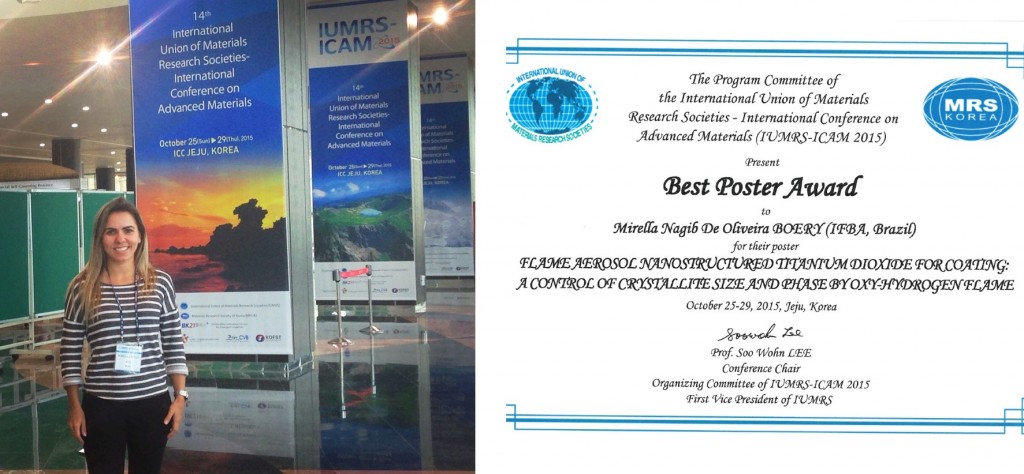
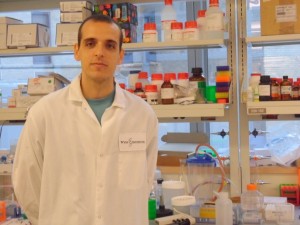
The scientific career of Edroaldo Lummertz da Rocha is permeated by two features of the area of Materials science and technology: interdisciplinarity and impact on people’s lives.
After graduating in Computer Science from Universidade do Extremo Sul Catarinense (UNESC), in the south of Brazil, Edroaldo got his master’s degree in Electrical Engineering at the Federal University of Santa Catarina (UFSC), with a study on the transport of phonons in fractal geometry. In 2010, he began a doctoratal program in Materials Science and Engineering, also at UFSC. With the advised of Professor Carlos Renato Rambo and Professor Luismar Marques Porto, Edroaldo worked on the interface among Materials Science, Computer Science and Biology to study the interaction between biological cells and bio and nanomaterials. In 2012, Edroaldo submitted, as first author, a scientific paper on simulations of interactions between nanoparticles and cell membranes. His paper was published in the journal Physical Chemistry Chemical Physics (DOI: 10.1039 / C2CP44035K) in 2013 and was featured on the front cover.
From January to December 2013, Edroaldo remained in the United States developing a part of his doctoral research at Harvard University (United States), more precisely in the Wyss Institute for Biologically Inspired Engineering, a multidisciplinary and multiinstitutional entity dedicated to the development of materials and devices inspired in nature, aimed at transforming medicine and building a more sustainable world. There he was advised by Professor Donald E. Ingber, founder and director of Wyss.
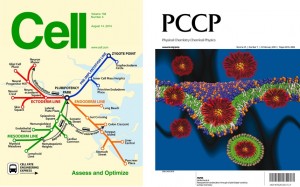
A second journal cover (DOI:10.1016/j.cell.2014.07 .020) increased Edroaldo´s curriculum in 2014 as a result of his participation, along with researchers at Harvard University and other institutions in the United States, in a Cell Engineering field study.This time the distinction was in Cell, the prestigious journal of Life Sciences, whose impact factor is 32.242.
In September 2014, Edroaldo obtained his PhD degree by defending his dissertation entitled “Nanoparticle-cell interactions and biomaterial-cells induce global changes in gene expression programs“. A year latter, the work was distinguished as the best dissertation defended in Brazil in 2014 by Capes, the government agency linked to the Brazilian Ministry of Education in charge of promoting high standards for post-graduate courses in Brazil. Edroaldo received the news of the award in the city of Rochester, in the United States, where he works in scientific activities as a postdoctoral fellow of the Mayo Clinic, an institution in the field of Medicine dedicated to research, education and patients´ care.
Interview with Edroaldo.
SBPMat Newsletter: – Could you tell us very briefly how did you become interested in science and in the Materials area, and what were the most important moments in your academic career so far?
Edroaldo Lummertz da Rocha: – My interest in science arose from the possibility of doing something important and helping people somehow. My interest in the Materials area arose due to the existence of a special class of materials, called nanomaterials, which can be used for the development of new therapies for a variety of diseases such as cancer, vascular and neurodegenerative diseases. However, the understanding of how nanomaterials interact with cells and biological tissues is extremely important for the development of safe and effective therapies.
The first most important event of my academic career was when Professor Carlos Renato Rambo, of the Federal University of Santa Catarina, agreed to be my advisor during my doctoral period. That’s where it all began. The second most important moment was when I had the opportunity to conduct part of my doctorate studies at the Wyss Institute at Harvard University, which significantly contributed to the development of my academic career.

SBPMat Newsletter: – What, in your opinion, is the main contribution of your award-winning thesis?
Edroaldo Lummertz da Rocha: – The main contribution of my thesis was the development of computational approaches to systematically understand how cells interact with nanomaterials and respond to external stimuli. This can serve as a basis for future studies in the field of development of new drug delivery systems and lead to a better understanding of how gene expression programs change when nanomaterials interact with cells.
SBPMat Newsletter: – Which criteria guided you to make a quality research highlighted at national level (the award-winning thesis)? To what factors do you attribute this achievement?
Edroaldo Lummertz da Rocha: – Dedication, discipline, creativity and a good team and co-workers are essential to progress in any area. Family support is essential, above all. From the point of view of the thesis, under the guidance of Professor Carlos Renato Rambo, I had the opportunity to work in a variety of projects and this contributed to the multidisciplinary nature of my thesis.
SBPMat Newsletter: – We invite you to leave a message for our readers who are conducting scientific research in the Materials area.
Edroaldo Lummertz da Rocha: – It is a long road, so you might as well enjoy the way. Being a scientist is something really rewarding, with new challenges and opportunities every day. The hope of discovering something important and providing a significant contribution is the driving force that guides my research. The effort is never in vain and there is always hope where there is perseverance.
More award-winners in the Materials field.
Several other works related to Materials Science and Engineering were awarded this year with the Capes Thesis Award, which was awarded to the best doctoral theses in 2014 in each of the 48 areas of knowledge recognized by Capes in postgraduate courses. The announcement of the winners was made on August 31 and the awards event will take place on December 10 in Brasilia city, the capital of Brazil. Here follow some examples related to Materials area:
– Honorable Mention in the Materials area. Thiers Massami Uehara. Study of the interaction of nanomaterials with models of cell membranes and neural stem cells. Advisor: Valtencir Zucolotto. Postgraduate Program in Science and Engineering of Materials – USP/SC. Dissertation file: http://www.teses.usp.br/teses/disponiveis/18/18158/tde-27102014-134646/pt-br.php
– Capes Award in Chemistry. Rodrigo Villegas Salvatierra. Thin Films of Conjugated Polymer and Carbon Nanostructures obtained in Liquid-Liquid Interfaces: Synthesis, characterization and application in photovoltaic devices. Advisor: Aldo José Gorgatti Zarbin. Postgraduate Program in Chemistry – UFPR. Dissertation file: http://dspace.c3sl.ufpr.br:8080/dspace/handle/1884/37915
– Honorable mention in Chemistry. Anderson dos Reis Albuquerque. Quantum-Chemical Study of the Ti(1-x)CexO2-δ in the Anatase Phase. Advisors: Ieda Maria Garcia dos Santos (DQ-UFPB) and Júlio Ricardo Sambrano (DM-UNESP Bauru). Postgraduate Program in Chemistry – UFPB. Thesis file: http://tede.biblioteca.ufpb.br/handle/tede/7154?locale=pt_BR. Report on CDMF website: http://www.nanotecnologia.com.br/trabalho-orientado-por-professor-do-cdmf-recebe-mencao-honrosa-no-premio-capes-2015/
[Paper: Strain Discontinuity, Avalanche, and Memory in Carbon Nanotube Serpentine Systems. Muessnich, Lucas C. P. A. M.; Chacham, Helio; Soares, Jaqueline S.; Neto, Newton M.; Shadmi, Nitzan; Joselevich, Ernesto; Cancado, Luiz Gustavo; Jorio, Ado. Nano Lett. 2015, 15 (9), pp 5899–5904. DOI: 10.1021/acs.nanolett.5b01982]
Vibrations of manipulated nanotubes.
Scientists from Brazilian institutions, in collaboration with researchers from Israel, “manipulated” carbon nanotubes of 1 nm diameter deposited on quartz surfaces and analyzed strain and displacements produced by this nanointervention. The team identified some behavior patterns in the nanotubes – quartz system and formulated a mathematical model applicable to systems formed by one- and two-dimensional materials over various substrates. The results of the study were recently published in Nano Letters.
To perform the experiments, the Brazilian investigators used samples idealized and produced in the Weizmann Institute of Science (Israel), in which the nanotubes are serpentine-shaped (composed of parallel segments connected together by U-shaped curves).These samples offered a desirable complexity, fostered by both the nanotubes format and the anisotropic character of quartz, which makes adhesion of nanotubes to the substrate not the same at all points.
In order to “manipulate” the system, the researchers used the tip of an atomic force microscope (AFM) built in the laboratory, which allows to change the position of nanometric particles and even of atoms, and to measure in situ the optical spectrum of nanostructures. In each sample, the tip touched a point of the quartz substrate and pushed toward the nanotube, and then proceeded to the optical analysis.
Before and after nanomanipulation, the scientists analyzed a number of points in the nanotube using the technique of Raman spectroscopy, which provides information about the frequency in which the atoms vibrate in the area being studied. More specifically, researchers focused on the frequency of the “G band”, which is used to infer the strain measurements of a considered point, since changes in the frequency of the “G band” are proportional to changes in strain.
Thus, scientists were able to identify and analyze different behavior of the nanotubes after nanomanipulation; for example, the detachment of the substrate and the intense displacement of a full stretch of the nanotube that had received two manipulations at the same point.
In addition to performing the experimental work, the authors of the article in Nano Letters managed to condense the complexity of behaviors they observed in a mathematical model (an equation) capable of explaining them theoretically and predicting these phenomena in similar systems. “The paper proposes a relatively simple model to describe complex effects of nanostructures adhesion in support media,” says Ado Jório, professor in the Department of Physics of the Federal University of Minas Gerais (UFMG) signing the letter as corresponding author.
The research that led to the Nano Letters article was developed within the master’s, doctoral and postdoctoral work of three authors of the letter, in the context of the Brazilian Network for Research and Instrumentation in Optical Nano-Spectroscopy, a project funded by the National Council for Scientific and Technological Development (CNPq) and coordinated by Ado Jório. “This is the result of a broad scientific instrumentation project, which aims at reaching the level of manipulating nanostructures and measuring, accurately, the effect of this process at the nanoscale,” says Jório.
The figure shows one of the 34 serpentine-shaped nanotubes on crystalline quartz substrate studied by the authors of the article. To the left of the reader is the nanotube before manipulation. To the right, following the sequence, the same nanotube after the intervention, with the consequent evident strain. The central segment of the nanotube, where the nanomanipulation occurred, was colorized, the gray scale indicating the frequency of the G band in that place. Finally, farther to the right, the chart displays the frequency of G band measured by Raman spectroscopy in successive points of this nanotube (graphical representation of gray hues): the black circles refer to non-manipulated nanotube and the gray colored circles, to the manipulated ones.
The special issue of IOP Conference Series dedicated to winners of the Bernhard Gross Award 2014 is already published on the web, with free and open access.
Through the Bernhard Gross Award, a prize for undergraduate and graduate students, the Brazilian Society for Research in Materials (SBPMat) annually distinguishes the best papers (one oral presentation and one poster, at the most) of each of the symposia of the society annual meetings. In 2014, the award highlighted twenty papers presented during the XIII SBPMat Meeting, which took place in the city of João Pessoa (PB) from September 28 to October 02, 2014.
The award-winning authors were invited by SBPMat to submit to peer review their works in the form of scientific articles, aiming at publishing them in the IOP Conference Series, dedicated to the publication of papers presented at scientific meetings. Among the articles submitted, 8 were accepted for publication and comprise this special issue.
See the volume dedicated to the Bernhard Gross Award 2014: IOP Conference Series: Materials Science and Engineering, Volume 97, conference 1.
|
||||||||||||||||||||||||
Cannot see this message? Click here.
Rodrigo Martins (Portugal, E-MRS immediate past president and IUMRS officer). He highlights the talent of the chairs to bring the right persons to discuss the most advanced topics in materials science and technology. He says this is the best meeting ever organized in Brazil.
Marco Cremona and Fernando Lázaro Freire Junior (Brazil, meeting chairs). They emphasize the broad spectrum of material science topics that was covered in the plenary lectures. They highlight the big number of students in the event and the active scientific discussion of the poster sessions. Besides, they compare the total attendance of this year´s meeting (2,000 people) with the first edition of the event (300 participants), also held in Rio de Janeiro in 2002.
Ahmet Hikmet Ucisik (Turkey, researcher at Atilim University). In Brazil for the 4th time, being the first one in 2007, he has noticed progresses of the country in materials science and engineering and the enthusiasm of young people.
Beth Mayes and Susan Curtis (USA and UK, Institute of Physics – IOP). They feature the way that the poster sessions were designed and the good attendance of the sessions.
Daniel Bahro (Germany, KIT), winner of Horiba and Bernhard Gross prizes. Electrical engineer. PhD student. Attending a conference for the first time. He presented his research results on organic tandem solar cells and won the prize for the best oral presentation of the meeting. So many young and enthusiastic people in the SBPMat meeting impressed him.
Victor R. Jauja Cana (Peru, Universidad Nacional de Ingeniería), Bernhard Gross prize winner. He has just finished a graduation course in Chemistry. He searched on the web for a conference to attend to present his development of an electrochemical sensor, decided to come to the SBPMat meeting, got financial support, had an oral presentation and, eventually, won a Bernhard Gross prize.
Lucas Pintol Nishikawa (Brazil, USP), recipient of a Bernhard Gross prize.He is starting a master course in Materials Engineering. In the SBPMat Meeting, his first conference, he won a prize for the oral presentation of a research work on heat treatment in steels. He expresses his surprise over the size and internationality of the SBPMat meeting.
And the last words, with Prof. Roberto Mendonça Faria (Brazil, SBPMat president), who says he was very happy to see, in the event, SBPMat growing and young people participating. He also stresses the high quality of several works he saw.
HORIBA AWARD
For the best oral presentation and the best poster of the meeting.
———————————————————————————————————
IUMRS AWARD
For the 3 best posters of the meeting.
——————————————————————————————————
BERNHARD GROSS AWARD
A recognition of SBPMat to the best oral and poster contributions of each symposium presented at the annual meeting of the society. The choice is made by a committee selected by the coordinators of each symposium. Bernhard Gross was one of the pioneers of Materials research in Brazil.
Symposium A.
Symposium B.
Symposium C.
Symposium D.
Symposium F.
Symposium G.
Symposium K.
Symposium M.
Symposium N.
Symposium O.
Symposium Q.
Symposium S.
Symposium V.
Symposium W.
Symposium X.
Symposium Y.
Workshop 1.
————————————————————————————————
E-MRS AWARD
For the best oral presentation and 2 best posters of symposium C.
Best oral presentation: Monique Gomes Teixeira (Universidade Federal de São João Del Rei). “Synthesis, characterization and photocatalytic application of ZnS nanocrystals”.
Best Poster, 1st position: José Antonio Souza (Universidade Federal do ABC). “ZnO microtubes decorated with nanowires”.
Best Poster, 2nd Position: Italo Odone Mazali (Universidade Estadual de Campinas). “Relation between the composition and the catalytic activity of the bimetallic noble metal nanoparticles with tunable compositions supported on organofunctionalized mesoporous silica”.
———————————————————————————————————
OPENING CEREMONY
Sunday, September 27. By 6:45 pm. Hundreds of people enter the plenary room of the Convention Center “SulAmérica”, in Rio de Janeiro (Brazil) for the opening ceremony of the 14th annual meeting of the Brazil Materials Research Society, whose acronym in Portuguese is SBPMat. The opening table is composed by the chairmen of the event, Prof. Marco Cremona (Brazil) and Prof. Fernando Lázaro Freire Junior (Brazil), as well as the present SBPMat president, Prof. Roberto Mendonça Faria (Brazil), the immediate past president of the European Materials Research Society (E-MRS), Prof. Rodrigo Martins (Portugal), and the general secretary of the International Union of Materials Research Societies (IUMRS), Prof. Robert Chang (USA). Behind them, a big banner shows the logos of dozens of institutions and companies that gave financial support to the event.

Near 1,000 attendants are present at the ceremony, which starts with the Brazilian national anthem. The chair Prof. Cremona welcomes the participants to the meeting. Prof. Robert Chang, who was president of MRS (Materials Research Society) in 1989 and founded IUMRS in 1991, convokes the participants of all countries to try to solve together the most important global challenges for materials research, related to health, food, environment, transport etc. Representing E-MRS, Prof. Martins, who presently takes care of Global Leadership and Service Award at IUMRS, emphasizes his desire of promoting international connections. Prof. Faria talks a little bit about Brazil, which, as well as other developing countries, is very rich in raw materials but needs to add value to its products by means of science and technology.
After the opening, Prof. Eloisa Biasotto Mano (Brazil) goes to the stage for the Memorial Lecture “Joaquim da Costa Ribeiro“, which is a distinction bestowed annually by SBPMat on a Brazilian researcher with outstanding career in the field of Materials. This 91-year-old scientist pursued international scientific education at a time when most women were illiterate in Brazil, and founded in the Federal University of Rio de Janeiro (UFRJ) the first research group in polymers in the country. This group later became the Institute of Macromolecules (IMA), which was directed by Eloisa until she retired. In the memorial lecture, she talks about macromolecular materials and, using a representation of a polyethylene molecule made by herself with wire, she shows how these kind of molecules behave in response to their big size. A group of Prof. Eloisa´s disciples (among them, the present director of IMA) assists her with the presentation, showing affection, gratitude and admiration for her . After the talk, many attendants of diverse ages make a queue to take a picture with this protagonist of the dawn of polymer science in Brazil. Eloisa, who is professor emeritus of UFRJ, poses for all the pictures she is ask to. At the end of the photo session, she accepts our microphone and leaves a message for the young people starting a carreer in science:
Right after the memorial lecture, in the same venue, the participants enjoy the welcome cocktail while meeting friends and collaborators. The cocktail is animated by live “chorinho” music, an instrumental Brazilian popular genre original from Rio de Janeiro.
———————————————————————————————————-
PLENARY LECTURES
Nader Engheta
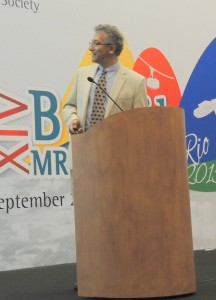
Monday, September 28. At 8:30 in the morning, the plenary room is full of attendants waiting to learn about metamaterials and the extreme behavior of waves interacting with them in the first plenary lecture of the event. The speaker is Nader Engheta, the H. Nedwill Ramsey Professor of Electrical and Systems Engineering at the University of Pennsylvania (United States). This Iranian-born scientist is a recognized world leader in research on metamaterials, and holds an H number of 69. Through experimental and theoretical research, Engheta and his collaborators have created such unconventional things as nanocircuits made of metamaterials that function as optical filters. Since the beginning of the talk, Engheta captivates the audience with some history of science and with a world of structures created by using particular composite metamaterials with particular sizes and geometries and arranged in particular ways with the aim of obtaining unconventional interaction with light and other waves.
————————————————————————————————————————————————————————–
Edgar Zanotto.

In the afternoon, at 3:30, more than 400 people attend the second plenary lecture, which is about glass-ceramics (materials formed through controlled crystallization of certain glasses). The speaker is the Brazilian researcher Edgar Zanotto, Professor at the Federal University of São Carlos (UFSCar), in Brazil, where he founded and heads the Vitreous Materials Laboratory (LaMaV) that assembles a big international team. Zanotto, who is a world-renowned expert on glass-ceramics, presents in his lecture many useful applications of these materials, such as cooking hobs or artificial bones and teeth. He also mentions the scientists who, along 60 years of glass-ceramics history, contributed to the advancement of research on that topic. In spite of those contributions, the comprehension of some aspects of the formation of glass-ceramics is not complete, he says, but that is not a problem for glass-ceramics fabrication and applications. It´s just an opportunity for fundamental scientists.
————————————————————————————————————————————————————————-
Paul Ducheyne. Biomaterials. Merging Materials Science with Biology.
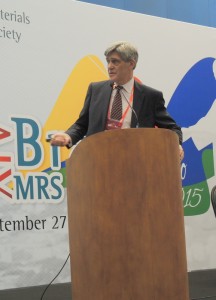
Tuesday, September 29. 8:30 am, time for the third plenary lecture of the event. The lecturer, Prof. Paul Ducheyne, also comes from University of Pennsylvania (USA), where he directs a multidisciplinary center for bioactive materials and tissue engineering research. An authority on biomaterials field, Ducheyne is the editor in chief of a six-volume book on biomaterials published in 2011. In the talk, he shows a series of biomaterial-made devices, grafts, scaffolds etc., most of them already being commercialized, that actively interact with the body, either by promoting tissue formation (for example, bone) or by releasing drugs for diverse treatments. Ducheyne presents their effects on solving health problems, numbers about their markets, and scientific recent advances that can make them even more effective.

Some hours later, at 3:30 pm, hundreds of participants cluster again, this time around Prof. Ulrike Diebold, whose research group at UT Wien (Austria) is devoted to the understanding of fundamental mechanisms and processes occurring in surfaces at the atomic scale. Prof. Diebold catches the audience attention from the beginning to the end by showing, through scanning tunneling microscopy images, how she spies the behavior of atoms on the surface of metal oxides – topic in which she is a worldwide leader researcher. In particular, she reveals two secrets of metal oxide surfaces: the first one about how oxygen adsorbs on titanium dioxide and the second one about how active single metal atoms are in oxidation process in magnetite.

Wednesday, September 30. In the plenary lecture of the morning, the audience is transported again to the social-impacting world of biomaterials by Prof. George Malliaras, Greek-born, working at École Nationale Supérieure des Mines de Saint-Étienne (France), where he heads the Department of Bioelectronics. Malliaras has an H index of 64. After many years working on organic electronics, he entered the new field of organic bioelectronics and obtained impacting results. His research is about electronic devices made of conducting polymers that match properties of living tissues. These devices are used for interfacing with human brain – a “natural electronic device”. The final purpose is to study brain activity or diagnose and even treat neurological diseases such as epilepsy. An example of device is a transistor that enables boosted in vivo recording of brain activity with low invasion. As suggestions for the materials community, Malliaras highlights the importance of collaboration with neuroscientists and physicians and the challenge of improving the understanding of electronic transport and structure.
————————————————————————————————————————————————————————–
Ichiro Takeuchi. Combinatorial Approach to Materials Discovery.
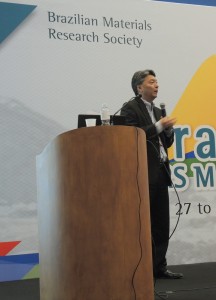
In the talk of the afternoon, the speed of science progress accelerates following the beat of the combinatorial approach. Prof. Ichiro Takeuchi, from University of Maryland (USA), explains how his group manages to optimize materials and properties discovery. As well as in lottery one can buy a big number of tickets to have more chances to win a prize, in materials discovery scientists can produce a huge number of combinations of elements to obtain a compound with desirable properties. For example, for quaternary compounds, millions of combinations are possible, from which only 0,01 % are known. In Prof. Takeuchi´s lab, machines for thin film deposition used with masks work night and day to create patchwork-like samples containing libraries of similar compounds. Then, the libraries are characterized by rapid tools, giving information about the properties of several compounds at the same time. Coupled with appropriate theory and computational simulations, these high-throughput experiments become real materials discovery engines.
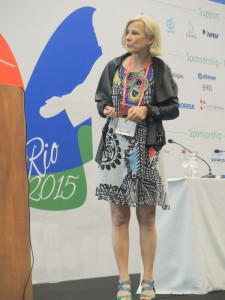
Thursday, October 1st, 8:30 am. In the last plenary lecture of the event, Prof. Claudia Draxl (Humboldt University, Germany) publicly wonders how to make available the huge amount of data resulting from experiments around the world, high-throughput screening, computer clusters etc. Why to do that with scientific data? For confirmation, broad dissemination in society, sharing with distant collaborators and reuse with new purposes. With that aim, Prof. Draxl and collaborators from European countries are facing the development of a repository of materials raw data, called Novel Materials Discovery (NoMaD), which hosts, organizes and shares materials data on the web.
SYMPOSIA SESSIONS

The symposia at SBPMat annual meetings are selected from proposals that can be submitted to the event committee by any scientist from anywhere in the world. This edition of the event encompassed 26 symposia (including the satellite event “8th International Summit on Organic and Hybrid Solar Cells Stability”) and 2 workshops, and it registered symposia coordinators from Argentina, Denmark, England, France, Germany, Italy, Ireland, Japan, Portugal, Spain, Swiss, USA, and, of course, Brazil. Within the symposia, near 190 invited speeches and more than 2,000 technical works are presented and discussed in oral and posters sessions, on a wide range of subjects going from carbon nanostructures to biomaterials, from characterization techniques to computer simulation, from materials for sustainable development to safe use of nanomaterials.
While some symposia have been held year after year in the SBPMat meeting, the University Chapters symposium was a novelty of this year meeting. It was completely organized by students from diverse points of Brazil who are coordinators of the SBPMat University Chapters. The chapters are organized teams, affiliated with the society, composed of graduate and undergraduate students working in materials field. The members of these groups carry out diverse activities that complement their academic education. The students from the existing chapters, which were eight in number up to the moment of the meeting, faced the challenge of organizing a symposium – a task that is usually done by senior researchers.
In fact, students have not only active but also massive participation in the XIV SBPMat meeting. Almost half of the attendants (950 people) were master, doctoral and even undergraduate students doing research on materials field. In Brazil, the federal agency for research support, CNPq, has a program called “scientific initiation” that grants scholarships to undergraduate students to conduct research under the supervision of a Professor.
For the oral sessions of the symposia, all along the meeting, after the morning plenary session, and before and after the afternoon plenary talks, the attendants distributed themselves among 17 rooms. The poster sessions took place at the end of the afternoon from Monday to Wednesday and in the morning on Thursday. Walking through the long corridors of the poster sessions, one could see active scientific discussion, many times between a young author and a renowned researcher. One could also hear very positive comments about the original arrangement of the poster panels. The size of the poster session was impressive. In total, near 1,800 research works were presented in the posters.
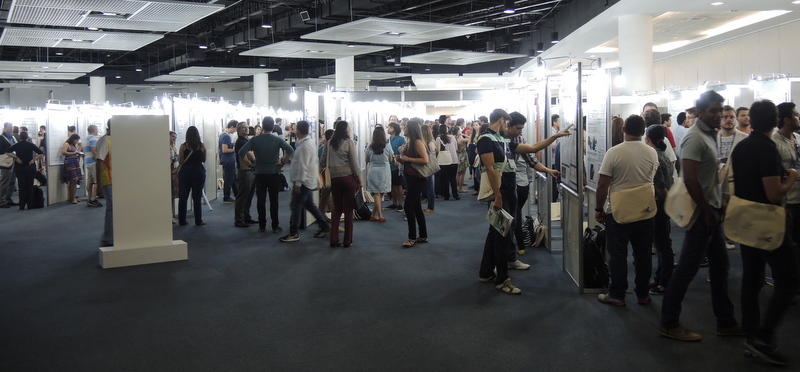
———————————————————————————————————————————————————————————
EXHIBITION
Twice a day from Monday to Wednesday, the attendants could take a break and have a coffee with cookies while visiting the exhibition of the event, which encompassed 32 stands showing a variety of scientific instruments, services, scientific journals, books and opportunities for the materials community. In addition, on Wednesday, the participants had the opportunity to attend four hours of technical talks given by some expositors about fabrication and characterization techniques.
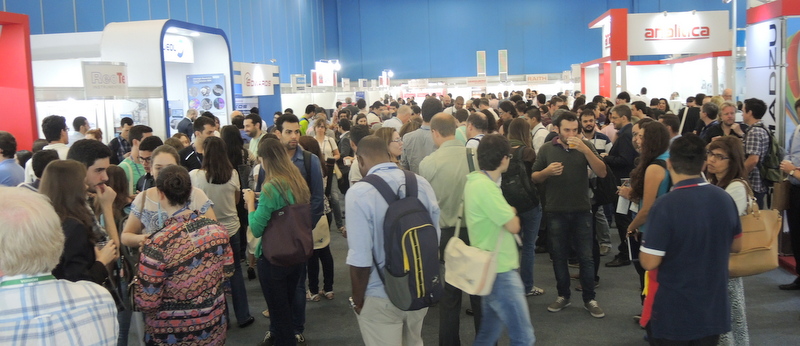
——————————————————————————————————————————————————————————
CLOSING AND AWARDS CEREMONY
On Thursday by 12:30 the closing ceremony started. In the closing panel, Prof. Soo Wohn Lee, from MRS Korea and conference chair of the IUMRS-ICAM 2015, joined the representatives of SBPMat, E-MRS and IUMRS.
In his final remarks, the meeting chair Prof. Cremona presented some photos of the past days and hours that made the public remember so nice and fruitful moments. He also presented the numbers of the event: 2,000 registered people from 985 institutions, among which 300 were foreign researchers from 40 countries. Finally, he announced that the next SBPMat annual meeting will be held in Campinas city (São Paulo state).
After the closing words, more than 20 prizes were given to young researchers within four different awards: the Bernhard Gross Award, a traditional SBPMat recognition for the best works of students, and the awards bestowed by IUMRS, E-MRS and Horiba.
